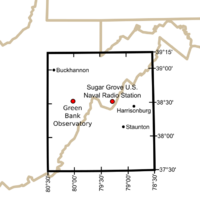Astronomy:Radio quiet zone
A radio quiet zone is an area where radio transmissions are restricted in order to protect a radio telescope[1] or a communications station[2] from radio frequency interference. The Radio Regulations of the International Telecommunication Union (ITU) define interference as being detrimental to radio astronomy if it increases measurement uncertainty by 10%. In particular, the applicable regulation is known as ITU-R Recommendation RA.769, "Protection criteria used for radio astronomical measurements".[3] Equipment that can cause interference includes mobile phones, television transmitters, and CB radios, as well as other electrical equipment.[1]
Quiet zones are located in areas that are sparsely populated, and may be enforced by government legislation.[1] A radio quiet zone is often divided into two zones: an exclusion zone where all radio emissions are prohibited, and a larger coordination zone of up to 100 km2 where the power levels of radio transmissions are suitably limited so as not to interfere with the radio telescope.[3]
Formal radio quiet zones exist around many observatories,[4] including the Murchison Radio-astronomy Observatory in Australia,[1] the National Radio Astronomy Observatory and the Sugar Grove Station in West Virginia, United States (the United States National Radio Quiet Zone),[2] the Itapetinga Radio Observatory in Brazil,[5] and MeerKAT in South Africa as examples.
The ITU has recommended designating two locations in outer space as radio quiet zones: the shielded zone on the Moon's far side, and the Sun-Earth Lagrangian point L2.[6]
See also
- Radio spectrum pollution
- United States National Radio Quiet Zone
References
- ↑ 1.0 1.1 1.2 1.3 "Radio quiet in the Mid West" (in en). Australian Government, Department of Innovation, Industry, Science and. http://www.ska.gov.au/Observatory/Pages/RadioQuiet.aspx. Retrieved 13 April 2017.
- ↑ 2.0 2.1 "National Radio Quiet Zone — Science Website" (in en). https://science.nrao.edu/facilities/gbt/interference-protection/nrqz/. Retrieved 13 April 2017.
- ↑ 3.0 3.1 van Driel, W. (June 2011), "Radio quiet, please! - protecting radio astronomy from interference", The Role of Astronomy in Society and Culture, Proceedings of the International Astronomical Union, IAU Symposium, Volume 260, p. 457-464, 260, International Astronomical Union, p. 457, doi:10.1017/S1743921311002675, Bibcode: 2011IAUS..260..457V.
- ↑ Umar, Roslan; Abidin, Zamri Zainal; Ibrahim, Zainol Abidin (8 May 2013). "The importance of Radio Quiet Zone (RQZ) for radio astronomy". AIP Conference Proceedings 1528 (1): 32–37. doi:10.1063/1.4803564. ISSN 0094-243X. Bibcode: 2013AIPC.1528...32U.
- ↑ "Radiobservatório do Itapetinga - ROI/INPE". http://www.cea.inpe.br/roi/zonasilencio.php. Retrieved 9 October 2017.
- ↑ Cohen, J. et al. (April 2003), "Radio Quiet Zones", in Schwarz, H. E., Light Pollution: The Global View, Astrophysics and Space Science Library, 284, Kluwer Academic Publishers, Dordrecht, p. 225, doi:10.1007/978-94-017-0125-9_21, Bibcode: 2003ASSL..284..225C.
External links
 |


